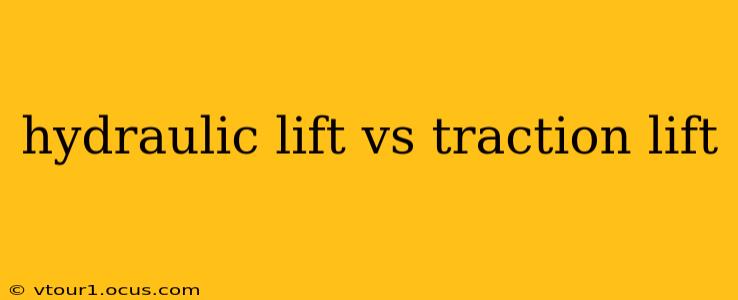Choosing the right elevator system for your building is a crucial decision, impacting efficiency, cost, and long-term maintenance. Two primary types dominate the market: hydraulic lifts and traction lifts. Understanding their differences is key to making an informed choice. This comprehensive guide will delve into the pros and cons of each, helping you determine which best suits your needs.
What is a Hydraulic Lift?
Hydraulic lifts use a hydraulic piston and fluid pressure to move the elevator car. A pump pushes hydraulic fluid into a cylinder, forcing a piston to raise the car. The fluid is then released to allow the car to descend. This system is typically used for low-rise buildings (up to six stories).
Advantages of Hydraulic Lifts:
- Simpler mechanics: Hydraulic lifts have fewer moving parts than traction lifts, potentially leading to lower initial installation costs and simpler maintenance.
- Smaller machine room: Because the hydraulic pump and other components can be located remotely, hydraulic systems often require a smaller machine room than traction lifts. This is advantageous in buildings with limited space.
- Smooth, quiet operation: The hydraulic system often provides a smoother, quieter ride compared to some traction systems, especially at low speeds.
- Lower energy consumption (at low speeds and short travel): For low-rise buildings with infrequent use, hydraulic lifts can be more energy-efficient than traction lifts at low speeds and short travel distances.
Disadvantages of Hydraulic Lifts:
- Limited height: Hydraulic lifts are generally not suitable for tall buildings due to the limitations of the hydraulic cylinder length and the increasing pressure needed for greater heights.
- Slower speed: They are typically slower than traction lifts, which can impact efficiency in taller buildings.
- Higher energy consumption (at higher speeds and long travel): The inefficiency increases substantially with higher speeds and longer travel distances.
- Environmental concerns: Hydraulic fluid can pose environmental hazards if leaked, requiring careful management and disposal.
- Potential for leaks: Hydraulic systems can be prone to leaks, potentially leading to downtime and maintenance costs.
What is a Traction Lift?
Traction lifts use a counterweight system and steel cables or belts to move the elevator car. A motor drives the sheaves, which in turn move the cables, raising or lowering the elevator car. This system is commonly used for mid-rise and high-rise buildings.
Advantages of Traction Lifts:
- Higher speed and capacity: Traction lifts offer significantly faster speeds and higher load capacities, making them ideal for taller buildings with high traffic volume.
- Suitable for high-rise buildings: Their design allows for greater heights without the limitations of hydraulic cylinders.
- Energy-efficient for tall buildings: Modern traction lifts are designed for energy efficiency and often incorporate regenerative braking systems that recover energy during descent.
- Relatively low maintenance: While requiring regular maintenance, they typically experience fewer major repairs compared to hydraulic lifts.
Disadvantages of Traction Lifts:
- Higher initial cost: The complex machinery and installation process for traction lifts result in significantly higher initial investment.
- Larger machine room: Traction lifts require a larger machine room to house the motor, sheaves, and other components.
- More complex maintenance: Though generally less prone to major failures, traction lifts have more moving parts, requiring more specialized maintenance.
- Potentially noisier operation: Depending on the design, traction lifts can be noisier than hydraulic systems.
Hydraulic Lift vs. Traction Lift: Which is Better?
There's no single "better" option; the ideal choice depends entirely on the specific needs of your building. Consider the following factors:
- Building height: Hydraulic lifts are suitable for low-rise buildings, while traction lifts are necessary for mid-rise and high-rise structures.
- Traffic volume: High traffic buildings require the speed and capacity of traction lifts.
- Budget: Hydraulic lifts typically have lower initial costs, while traction lifts necessitate a higher upfront investment.
- Energy efficiency: While hydraulic lifts might be slightly more energy-efficient at low speeds and short distances, traction lifts often prove more energy-efficient in taller buildings with frequent use, thanks to regenerative braking.
- Maintenance requirements: Hydraulic systems can experience higher maintenance needs due to potential leaks, while traction lifts often require more specialized maintenance personnel.
Frequently Asked Questions (FAQs)
What is the lifespan of a hydraulic lift vs. a traction lift?
Both hydraulic and traction lifts can have a long lifespan, typically 20-30 years or more, provided they receive proper maintenance. However, various factors can impact this, including usage frequency and the quality of maintenance.
Which type of lift is more environmentally friendly?
Modern traction lifts with regenerative braking systems often prove to be more environmentally friendly due to their superior energy efficiency. Hydraulic systems pose environmental risks due to potential fluid leaks.
What are the running costs for each type of lift?
Running costs vary greatly depending on factors such as building height, usage frequency, and energy prices. Traction lifts, while having a higher initial cost, might have lower operating costs in the long run for high-rise buildings due to regenerative braking and potentially less frequent repairs. In low-rise buildings, hydraulic lifts might have lower running costs due to their simpler mechanics, but this is dependent on building usage.
Can I retrofit an existing hydraulic lift to a traction lift?
Retrofitting is often possible but usually expensive and complex, often involving significant structural modifications. It's usually more economical to replace the lift entirely than to undertake such a retrofit.
By carefully considering these factors and weighing the advantages and disadvantages of each system, you can make an informed decision that best suits your building's specific requirements and ensures a safe, efficient, and cost-effective elevator solution.
